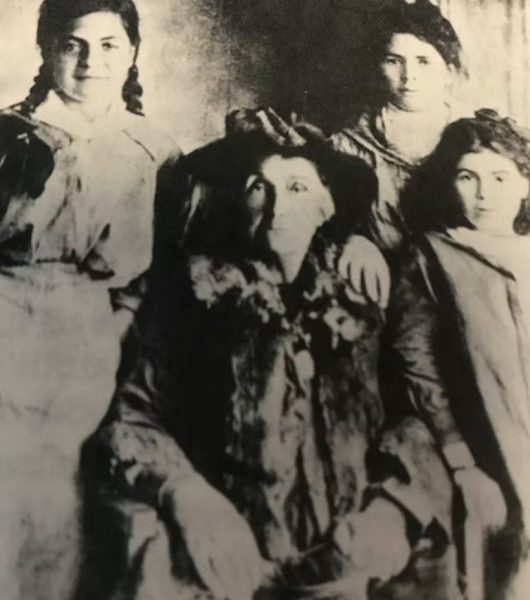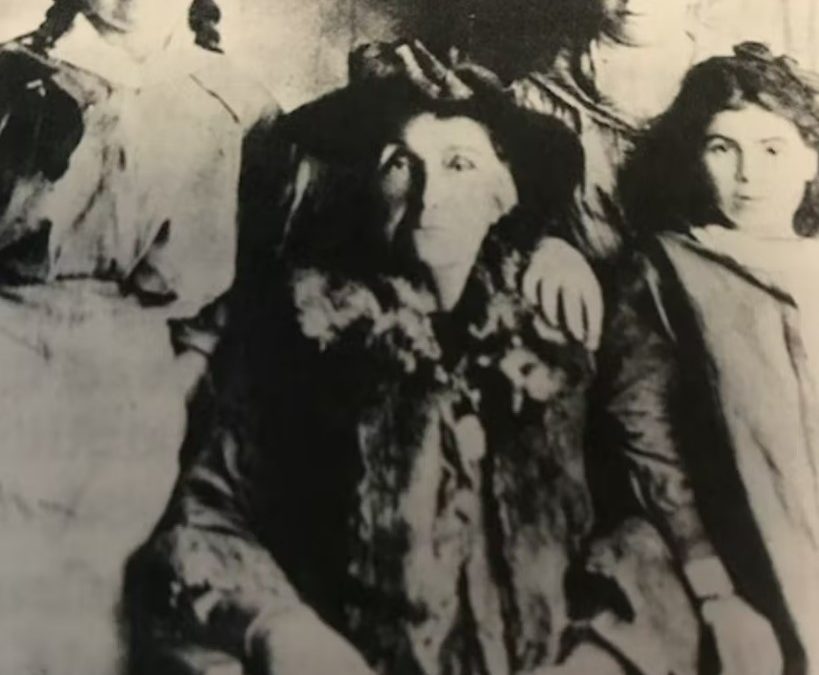Written by Elizabeth Heffernan, RAHS Volunteer
To celebrate Women’s History Month in 2022, the Royal Australian Historical Society will continue our work from previous years to highlight Australian women that have contributed to our history in various and meaningful ways. You can browse the women featured on our webpage, Women’s History Month.
Aboriginal and Torres Strait Islander people are advised that this webpage contains the names of people who have passed away.
Affectionately known as ‘Queenie Cain’ or ‘Queen Mary Jane’, Mary Jane Cain was a proud Gomeroi woman from the Coonabarabran region of NSW who rose to prominence in the late 1880s when she single-handedly secured a parcel of land for her family at Forky Mountain. This land, and the Aboriginal community that flourished from it, became known as Burra Bee Dee.

MARY JANE CAIN (CENTRE) WITH GRANDDAUGHTERS MILEY BARKER AND MOLLY CHATFIELD AND HER GREAT NIECE JOSEPHINE. THE SUN DANCIN’ : PEOPLE AND PLACE IN COONABARABRAN (ABORIGINAL STUDIES PRESS, 1994)
Queen Mary Jane is remembered as its first beloved matriarch.
Born in 1844 at Toorawandi, Mary Jane was brought up in an Australian interior still grappling with its European colonisers, who first crossed the Blue Mountains in 1813. Her mother, Jinnie Griffin, likely experienced life both pre- and post-invasion. [1]
Mary Jane married Joseph Budsworth at Mudgee in 1857, when she was only thirteen years old. They had two children before Joseph’s death in 1863. In 1865, Mary Jane wed again, this time to stockman George Cain. They were married by Reverend Alexander McEwan at Wetalabah station, in the McGregor family’s “best parlour”. [2]
Some versions of Mary Jane’s story assert that twenty years into their marriage, George became ill, prompting Mary Jane to petition the crown for land at Forky Mountain to support him and their nine children. [3] Others suggest that Mary Jane’s goats strayed to Forky Mountain every day. Tired of herding them back home again, Mary Jane and George settled at Forky Mountain in 1885. Only after a community had been established there did Mary Jane travel to Sydney to lobby for an official gazettal of the land as an Aboriginal reserve. [4] All versions agree this was granted in 1892.
Mary Jane’s achievement, though remarkable, was not unique. Between 1885 and 1895, Aboriginal families initiated more than half the land reserves granted to them. [5] But Mary Jane’s legacy lies not only in the land she managed to secure from the crown, but the community she helped build on it. Burra Bee Dee became home to displaced Aboriginal families across the region from its establishment through to the late 1950s. Until her death in 1929, Mary Jane was at the centre of it all.
Queenie Cain was “known and loved by all from a very great distance round this district and outside it”. She was kind, generous, an excellent cook and seamstress, and “[gave] her people the strength to move forward” in difficult and changing times. [6]
Mary Jane penned a manuscript recounting her life and the history of the Coonabarabran district in 1920. It concludes with four pages of Gomeroi name meanings. Coonabarabran is “an inquisitive person”, Mudgee “sharpening stone”, Toorawandi “a row of standing stones”, and Burra Bee Dee “flying mice”. [7] The manuscript, today more than one hundred years old, is a written record ensuring the survival of Mary Jane’s traditional language, just as the land at Forky Mountain ensured the Aboriginal community in the area could live on in peace.
References:
[1] Marilyn Wood, ‘The journey to “Forked Mountain”’, Aboriginal History 25, Special section: ‘Genocide’?: Australian Aboriginal history in international perspective (2001), p. 209.
[2] Mary Jane Cain, ‘Mary Jane Cain reminiscences of Coonabarabran, New South Wales and district, 1844-1926’, 1844-1926, State Library of NSW, accessed 2 March 2022, https://collection.sl.nsw.gov.au/record/94RxaqZ1.
[3] Heidi Norman, ‘Hidden women of history: Mary Jane Cain, land rights activist, matriarch and community builder’, The Conversation, 25 January 2019, https://theconversation.com/hidden-women-of-history-mary-jane-cain-land-rights-activist-matriarch-and-community-builder-110186.
[4] Inscription on the 50 Years’ Service Coonabarabran Rotary Club monument, accessed 2 March 2022, https://www.monumentaustralia.org.au/themes/culture/community/display/102767-50-years-service-coonabarabran-rotary-club-mary-cain-.
[5] Norman, ‘Hidden women of history’.
[6] Norman, ‘Hidden women of history’; Margaret Somerville, Body/landscape journals (North Melbourne: Spinifex Press, 1999); Margaret Somerville, Marie Dundas, May Mead, Janet Robinson, and Maureen Sulter, The sun dancin’ : people and place in Coonabarabran (Canberra: Aboriginal Studies Press, 1994).
[7] Cain, ‘Mary Jane Cain reminiscences’.


0 Comments